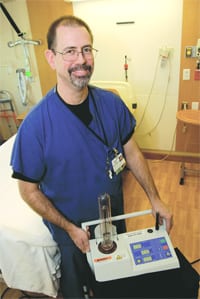Cooley Dickinson Hospital Disinfects Rooms with Flashing UV Light
NORTHAMPTON — Cooley Dickinson Hospital has announced that it is the first hospital in New England to use the Xenex PX-UV Disinfection System to disinfect its patient and operating rooms.
Scientifically proven to kill all major classes of microorganisms that cause hospital-acquired infections and ‘superbugs’ such as methicillin-resistant staphylococcus aureus (MRSA), clostridium difficile (C-diff.), and flu viruses, among other germs, the Xenex system is, according to the hospital, the fastest, safest, and most effective method for the advanced cleaning of hospital and operating rooms.
“Years ago, automobile manufacturers installed airbags because seatbelts were not enough, and created a new standard of safety. With the Xenex technology, CDH is taking infection prevention and patient safety to the next level,” Carol Smith, chief operating officer, said of the hospital’s decision to adopt the disinfection system, which staff started using several weeks ago.
Hospital-acquired infections (also referred to as health care-associated infections) caused by ‘superbugs’ such as MRSA and C-diff. are the fourth-leading cause of death in the U.S., according to the Centers for Disease Control and Prevention. MRSA is an infection that resists antibiotics. C-diff. is a bacteria that can cause diarrhea and, when severe, can cause sepsis and death.
Dr. Joanne Levin, medical director of infection prevention at CDH, said the C-diff. germ is on the rise, and disease and death from this infection has risen dramatically. “One type of C-diff. germ has a hard shell, like a seed, that protects it from traditional cleaning products such as bleach. It can live in an environment for a month or more,” she noted. One approach that can kill the C-diff. spore is the pulsed UV light.
“The light penetrates the cell wall of the bacteria and makes the DNA clump together,” Levin explained. “So the germs can’t reproduce; they die, and the transmission cycle is stopped.”
The Xenex system uses pulsed xenon technology to deliver high-intensity, broad-spectrum UV light to quickly kill microorganisms on surfaces and in the air without contact or additional chemicals. The UV light penetrates the cell walls of microorganisms — fusing their DNA — leading to instant damage (the inability to reproduce or mutate) and killing the organism.
By disabling spores and germs, the UV technology lowers the number of infection-causing microorganisms and prevents the spread of infection. Infection Prevention Manager Linda Riley noted that, “compared to other hospitals and industry standards, CDH’s infection rates are already low. But our goal is zero. Adopting the UV technology helps us to continue to reduce our infection rates while improving care for our patients.”
Brian Cruver, CEO of Xenex Healthcare, said that “hospitals need to protect patients by completely disinfecting the rooms, and innovative hospitals like Cooley Dickinson are utilizing our proven room-disinfection technology to accomplish this. Making the Xenex system part of their standard cleaning procedure will help Cooley Dickinson prevent infections and save patient lives.”
Added Riley, “if a cell can’t reproduce, it can’t live on surfaces. And it will not cause infection.”



Comments are closed.